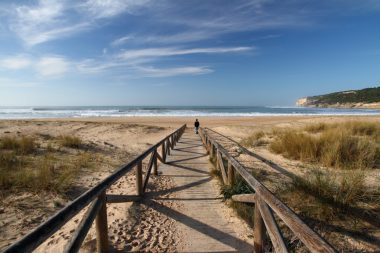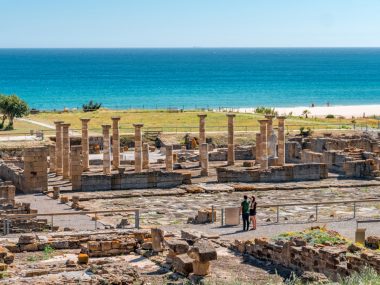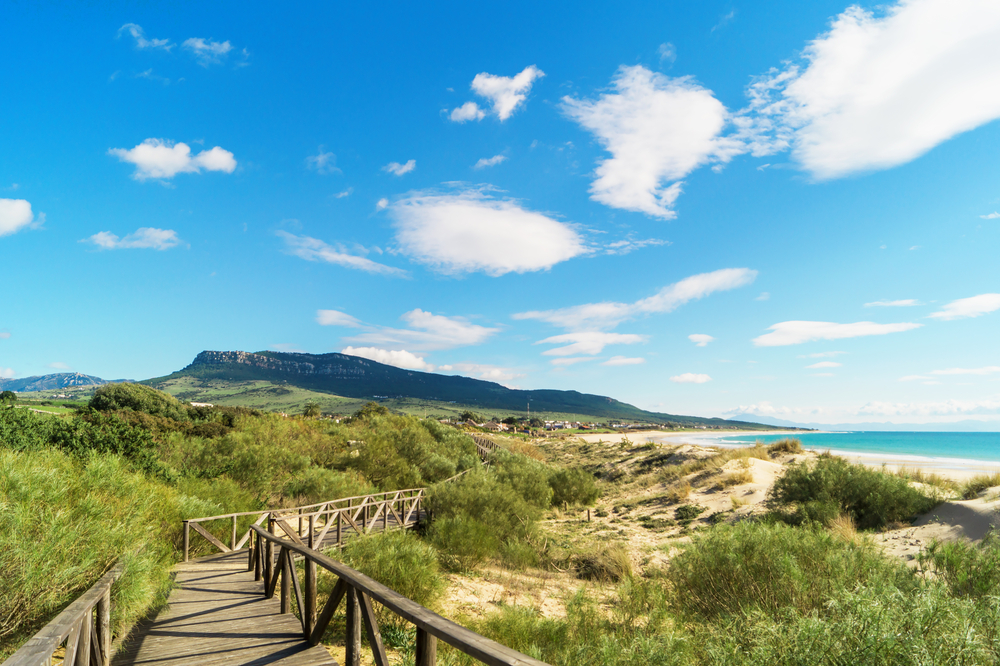The 200-kilometre-long Costa de la Luz owes its picturesque sunsets to its location on the Atlantic coast in the far southwest of Andalusia on the border with neighbouring Portugal , which make the region shine in warm golden tones every evening. Between the lively port city of Huelva and the famous surfing stronghold of Tarifa, holidaymakers will find countless fine sandy beaches, majestic dunes and fragrant pine forests as well as authentic holiday resorts with a wide range of accommodation.
Although the Costa de la Luz is strongly influenced by tourism in many places, it also has extremely quiet and almost deserted areas where fauna and flora can develop undisturbed. These include first and foremost the almost 550 km² “Coto de Doñana” National Park in the estuary of the Guadalquivir River, whose periodically flooded wetland serves as a habitat for thousands of bird species. On hikes from Palacio del Acebron, El Rocío and Matalascañas or boat tours on the Guadalquivir from Sanlucar de Barrameda, you might even get to see the rare Iberian lynx.
There are many wide and long sandy beaches in the regional nature reserves

Another protected area worth seeing, which also has a popular bathing beach with the “Playa de la Hierbabuena”, which is a good one kilometre long, is the 5,000-hectare national park “La Breña y Marismas del Barbate” in the area of the two municipalities of Barbate and Vejer de la Frontera in the Province of Cádiz. The wetland is located due to its proximity to the Strait of Gibraltar a preferred resting place among migratory birds, where they also find enough fish as food as well as small amphibians and reptiles. With the historic dovecote “Palomar de La Breña” from the 18th century in San Ambrosio (Barbate), this national park also has the largest of its kind in the world. With an area of currently over 10,000 hectares, the nature park “Bahía de Cádiz” in the bay of the provincial capital of the same name is significantly larger. The many cycle paths make the park attractive among sporty active holidaymakers. The “Playa de Camposoto” near San Fernando (Cádiz), which has only been fully open to the public since the 1980s and until then used by the Spanish military as a manoeuvre area, is popular for swimming.
The constant sea breeze makes the Costa de la Luz a globally famous surfing paradise
At least as well known and popular as for its natural monuments, the Costa de la Luz is also a bathing and water sports paradise. The reliable winds, which blow strongly almost all year round, provide ideal conditions especially for surfing almost everywhere. In addition to the above-mentioned Tarifa, which is famous among surfers from all over the world, the beaches of Caños de Meca (Barbate) and La Fontanilla (Conil) have an excellent reputation among kitesurfers and windsurfers. The same applies to Playa de los Bateles (Conil), Playa de la Cortadura (Cádiz) and Playa Yerbabuena (Barbate), as well as Playa del Carmen (Barbate), Playa de Punta Umbría (Huelva) and Playa de Mazagón (Huelva). Traditional seaside resorts with corresponding infrastructure in the form of many accommodations and rental stations for equipment are for example Novo Sancti Petri (Chiclana) as well as El Palmar (Vejer de la Frontera) and Zahara de los Atunes (Barbate).
Mild climate and fish-rich sea made the area attractive as a habitat

There is also no shortage of historical cultural monuments worth seeing in towns and municipalities that are thousands of years old on the Costa de la Luz. Even the Romans appreciated the beautiful landscape and founded settlements that have been preserved as ruins to this day, such as “Baelo Claudia” near Bolonia northeast of Tarifa in the province of Cádiz. Also frequently visited and photographed are the former Roman port “Barbesula” near Sotogrande-San Roque (Cádiz), the Bronze Age necropolis “Necrópolis de los Algarbes” near Tarifa (Cádiz) and Cape Trafalgar (Cabo Trafalgar), where the legendary Battle of Trafalgar took place in October 1805, in which Admiral Nelson defeated the Spanish-French fleet, but also met his death. There are particularly numerous caves in the region that were used as living space in the Stone Age, which are decorated with still visible and impressive prehistoric rock paintings. Examples include the “Cueva de la Laja Alta” near Jimena de la Frontera (Cádiz), the “Cueva de Bacinete” near Los Barrios (Cádiz) and the “Cueva de las Bailadoras” near Los Barrios (Cádiz).
You will hardly find fresher fish in Spain than on the Costa de la Luz
The Costa de la Luz presents itself as an immensely scenic and also very versatile holiday area with numerous excursion and leisure opportunities. The many historic churches, monasteries and palaces in Ayamonte at the mouth of the Guadiana in the Atlantic Ocean on the border with Portugal in the province of Huelva are also worth a detour. Not far away is also the city of Isla Cristina with the popular promenade “Paseo de las Palmeras” as well as the seaside resort “Playa de Islantilla” and the hiking area “Marismas de Isla Cristina”. Punta Umbría has the UNESCO Biosphere Reserve in the “Marismas del Odiel” nature park as well as the beaches of La Bota, Los Enebrales, El Portil and Matanegra, and the “Playa de Matalascañas” is known for its golf courses. In Sanlúcar de Barrameda, Christopher Columbus began his third voyage to America in 1498, and in El Puerto de Santa María, many cozy sherry bodegas and restaurants for fish and seafood are welcomed.


